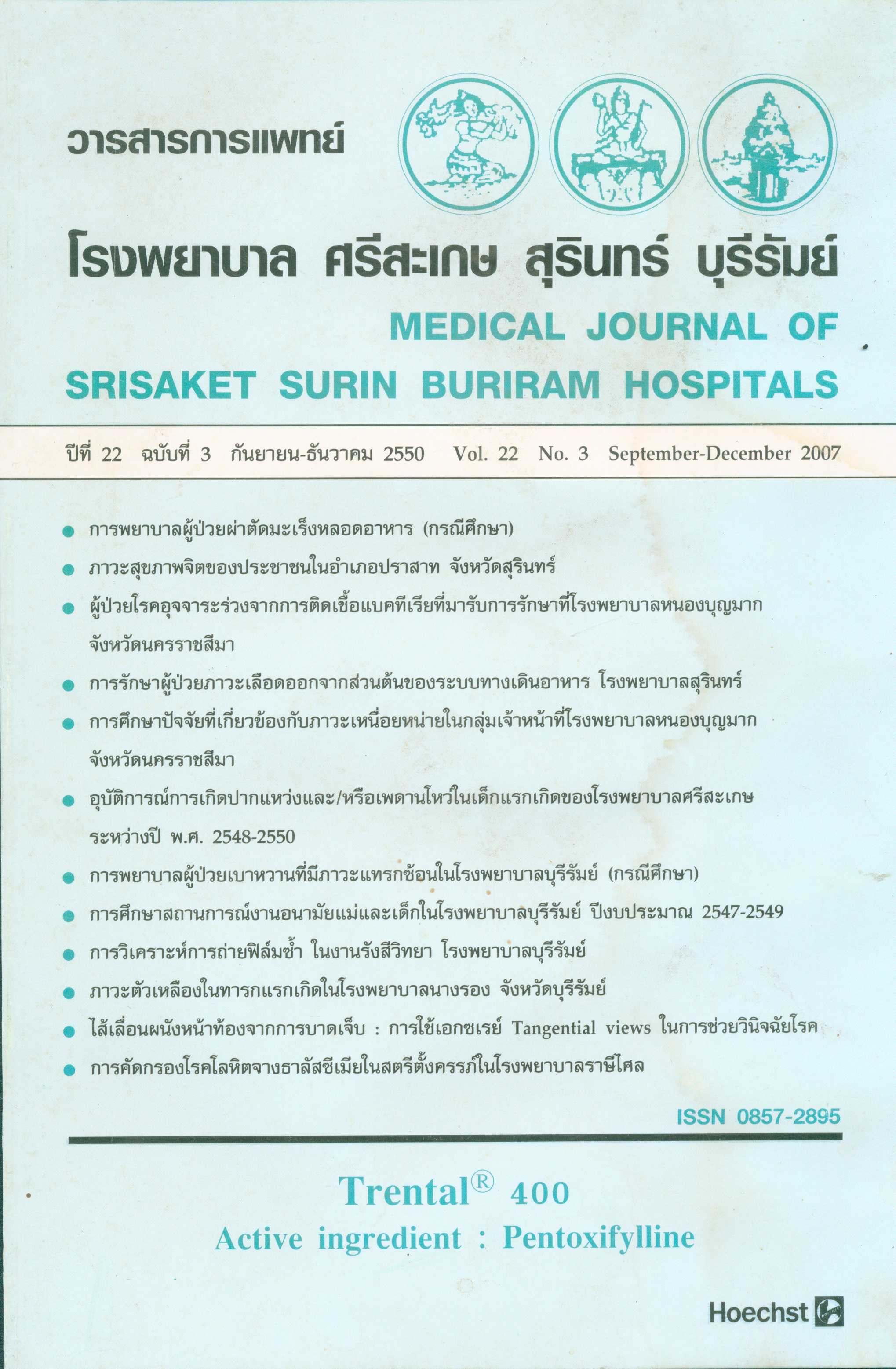การรักษาผู้ป่วยภาวะเลือดออกจากส่วนต้นของระบบทางเดินอาหารโรงพยาบาลสุรินทร์
Main Article Content
บทคัดย่อ
เหตุผลของการวิจัย: ภาวะเลือดออกเฉียบพลันจากส่วนต้นของระบบทางเดินอาหาร เป็นภาวะฉุกเฉินทางอายุรกรรม ซึ่งพบได้บ่อยและส่งผลกระทบรุนแรงต่อผู้ป่วยได้มาก อาจ รุนแรงถึงแก่ชีวิตการส่องกล้อง Esophagogastroduodenoscopy (EGD) เป็น เครื่องมือที่ดีและเหมาะสมในการวินิจฉัยและรักษาผู้ป่วยที่มาด้วยภาวะเลือดออก เฉียบพลันจากส่วนต้นของระบบทางเดินอาหาร ข้อมูลของผู้ป่วยและตลอดจน ผลการรักษาของผู้ป่วยกลุ่มนี้ในเขตอีสานใต้ของประเทศไทยยังมีจำกัด การศึกษา ข้อมูลดังกล่าวจะเป็นประโยชน์ในการรักษาผู้ป่วย ภาวะเลือดออกเฉียบพลันจาก ส่วนต้นของระบบทางเดินอาหารให้มีประสิทธิภาพดียิ่งขึ้นต่อไป
วัตถุประสงค์: เพื่อศึกษาลักษณะผู้ป่วย ผลการส่องกล้อง Esophagogastroduodenoscopy (EGD) ประสิทธิภาพของการรักษาด้วยการส่องกล้อง และผลการรักษาของ ผู้ป่วยภาวะเลือดออกเฉียบพลันจากุส่วนต้นของระบบทางเดินอาหารที่มารับการ รักษาที่โรงพยาบาลสุรินทร์ และเพื่อศึกษาความซุกและความสัมพันธ์ของเชื้อ Helicobacter pylori ในผู้ป่วยกลุ่มนี้
สถานที่ศึกษา: ห้องผ่าตัด, กลุ่มงานอายุรกรรมและกลุ่มงานศัลยกรรม โรงพยาบาลสุรินทร์
รูปแบบการวิจัย: เป็นการศึกษาย้อนหลัง
วิธีการศึกษา: ศึกษาเซิงวิเคราะห์โดยการเก็บข้อมูลย้อนหลัง ผู้ชายที่วินิจฉัยภาวะเลือดออก เฉียบพลันจากส่วนต้นของระบบทางเดินอาหาร ในโรงพยาบาลสุรินทร์ ตั้งแต่ 1 มกราคม 2548 - 31 ธันวาคม 2549 เป็นระยะเวลา 2 ปี การวิเคราะห์ปัจจัย ที่มีผลต่อการเกิดแผลเปปติค โดยใช้สถิติ Chi-square, และ Fisher’s exact test
ผลการศึกษา: มีผู้ป่วยภาวะเลือดออกเฉียบพลันจากส่วนต้นของระบบทางเดินอาหาร 802 คน ในการศึกษานี้ เป็นผู้ป่วยเพศขาย 513 คน (64%) เพศหญิง 289 คน (36%) อายุเฉลี่ย 57.11 ± 14.27 ปี สาเหตุที่พบมากที่สุดในผู้ป่วยภาวะเลือดออก เฉียบพลันจากส่วนต้น ระบบทางเดินอาหาร คือ Esophageal Varies พบได้ 269 คน (33.5%) ตรวจพบเชื้อ Helicobacter pylori ในผู้ป่วย non variceal bleeding 46% โดยวิธี rapid unease test และพบว่าผู้ป่วยที่มี duodenal ulcer พบเชื้อ Helicobacter pylori ได้ 71.9% ส่วนผู้ป่วย gastric ulcer พบเชื้อนี้ได้ 50.3% ซึ่งต่างกันอย่างมีนัยสำคัญทางสถิติ (P < 0.05) พบผู้ป่วย Variceal Hemorrhage สูงถึง 34.1% แสดงให้เห็นว่ามีผู้ป่วยภาวะโรคตับเรื้อรัง เป็นจำนวนมากในเขตนี้
ผู้ป่วยที่ได้รับการส่องกล้อง Esophagogastroduodenoscopy (EGD) และประสบความสำเร็จในการหยุดภาวะเลือดออกจากการส่องกล้องครั้งแรก เป็น 718 คน (89.5%) และมีผู้ป่วย 22 ราย (2.7%) ต้องได้รับการรักษาโดยการ ผ่าตัดเพื่อหยุดภาวะเลือดออก หลังจากได้รับการส่องกล้องแล้ว 2 ครั้ง ผู้ป่วย นอนรักษาในโรงพยาบาลโดยเฉลี่ย 4.31 ± 3.03 วัน อัตราตายในผู้ป่วยกลุ่มนี้ พบได้ 4.7%
สรุปผลการศึกษา: ผู้ป่วยที่มาด้วยภาวะเลือดออกเฉียบพลันจากส่วนต้นของระบบทางเดินอาหาร ควรจำเป็นต้องได้รับการรักษา โดยการส่องกล้อง Esophagogastroduodenoscopy ซึ่งเป็นเครื่องมือที่เหมาะสมในการวินิจฉัยและรักษาให้เลือดหยุดได้เป็นอย่างดี พบภาวะ Variceal bleedingได้บ่อยเป็นสาเหตุหลักในโรงพยาบาลสุรินทร์ ผู้ป่วย มี duodenal ulcer จะพบเชื้อ Helicobacter pylori ในลัดส่วนมากกว่าผู้ป่วยมี gastric ulcer อย่างมีนัยสำคัญทางสถิติ และผู้ป่วยภาวะเลือดออกเฉียบพลัน จากส่วนต้นของระบบทางเดินอาหาร ควรได้รับการส่องกล้อง EGD ภายโน 24 ชั่วโมง เพื่อวินิจฉัยและหยุดเลือดจะสามารถรักษาผู้ป่วยในกลุ่มนี้ได้อย่างมีประสิทธิภาพ
Article Details
เอกสารอ้างอิง
2. Jiranek GC, Kozarek RA. A cost-effective approach to the patient with peptic ulcer bleeding. Surg Clin North Am 1996;76:83-103.
3. Longstreth GF. Epidemiology of hospitalization for acute upper gastrointestinal hemorrhage: a population-based study. Am J Gastroenterol 1995;90:206-10
4. Cook DJ, Guyatt GH, Salena BJ, Laine LA. Endoscopic therapy for acute nonva-riceal upper gastrointestinal hemorrhage: a meta-analysis. Gastroenterology 1992; 102:139-48.
5. Katschinski B, Logan R, Davies J, Faulkner G, Pearson J, Langman M. Prognostic factors in upper gastrointestinal bleeding. Dig Dis Sci 1994;39:706-12. .
6. Forrest JAH, Finlayson NDC, Shearman DJ. Endoscopy in gastrointestinal bleeding. Lancet, 1974;2:394-7.
7. Beppu K, Inokuchi K, Koyanagi N, Nakayama S, Sakata H, Kitano S, Kobayashi M. Prediction of variceal hemorrhage by esophageal endoscopy. Gastrointest Endosc 1981;27:213-8.
8. Rockall TA, Logan RF, Devlin HB, Northfield TC. Incidence of and mortality from acute upper gastrointestinal haemorrhage in the United Kingdom. Br Med J 1995;311:222-6.
9. Yavorski RT, Wong RK, Maydonovitch C, Battin LS, Furnia A, Amundson DE. Analysis of 3,294 cases of upper gastrointestinal bleeding in military medical facilities. Am J Gastroenterol 1995;90: 568-73.
10. Gostout CJ, Wang KK, Ahlquist DA, Clain JE, Hughes RW, Larson MV, Petersen BT, Schroeder KW, Tremaine WJ, Viggiano TR. Acute gastrointestinal bleeding. Experience of a specialized management team. J Clin Gastroenterol 1992;14:260-7.
11. Peura DA, Lanza FL, Gostout CJ, Foutch PG, and Contributing ACG Members and Fellows. The American College of Gastroenterology bleeding registry : preliminary findings. Am J Gastroenterol 1997;6:924-8.
12. Gilbert DA, Silverstein FE, Tedesco FJ. The national ASGE survey on upper gastrointestinal bleeding. III. Endoscopy in upper gastrointestinal bleeding. Gastrointest Endosc 1981;27:94-102.
13. Morgan AG, MacAdam WA, Walmsley GL, Jessop A, Horrocks JC, de Dombal FT. Clinical findings, early endoscopy and multivariate analysis in patients bleeding from the upper gastrointestinal tract. Br Med J 1977;2:237-40.
14. Villar HV, Roberts Fender H, Watson LC, Thompson JC. Emergency diagnosis of upper gastrointestinal bleeding by fiberoptic endoscopy. Ann Surg 1977; 185:367-74.
15. Vreeburg EM, Snell P, Bruijne JW, Bartelsman JFWM, Rauws EAJ, Tytgat GNJ. Acute upper gastrointestinal bleeding in the Amsterdam area: incidence, diagnosis and clinical outcome. Am J Gastroenterol 1997;2:236-43.
16. Silverstein FE, Gilbert DA, Tedesco FJ, Buenger NK, Persing J. The National ASGE survey on upper gastrointestinal bleeding. II. Clinical prognostic factors. Gastrointest Endosc 1981;27:80-93.
17. Soehendra N, Bohnacker S, Binmoeller KF. Nonvariceal upper gastrointestinal bleeding. New and alternative hemostatic techniques. Gastrointest Endosc Clin North Am 1997;7:641-56.
18. Dagradi AE, Ruiz RA, Weingarten ZG. Influence of emergency endoscopy on the management and outcome of patients with upper gastrointestinal hemorrhage. Am J Gastroenterol 1979;72:403-15.
19. Foster DN, Miloszewski KJ, Losowski MS. Stigmata of recent haemorrhage in diagnosis and prognosis of upper gastrointestinal bleeding. Br Med J 1978; 1:1173-7.
20. Johnston JH. Endoscopic risk factors for bleeding peptic ulcer. Gastrointest Endosc 1990;36 Suppl:S16-S20.


